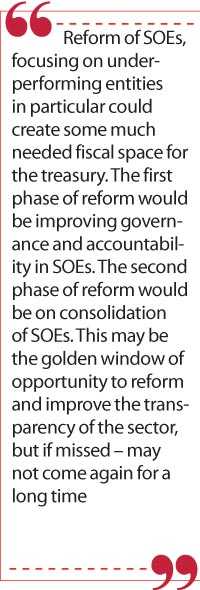Saturday Feb 22, 2025
Saturday Feb 22, 2025
Thursday, 25 June 2020 00:00 - - {{hitsCtrl.values.hits}}

With the harsh reality of a global recession slowly descending on Sri Lanka, questions about Government expenditure and its allocation of resources have begun to dominate dinner table discussions. Fears of higher taxation to cover the losses earned and to sustain the blows from the impending recession, have started to emerge.
There is a simple solution: introduce reforms to prevent areas for corruption and inefficiency within SOEs – thus preventing the State from bearing tremendous losses.
However, there is hesitation and discomfort amongst the general public, when consolidation or privatisation of SOEs are discussed. This begs the question: why?
Why are SOEs so popular amongst the public?
One of reasons could be due to the portrayal and framing of the SOE sector, over the years. SOEs are perceived by the public as a source of stable employment as well as a source of goods and services at affordable prices. This perception is backed up by the fact that the SOEs hire over 200,000 people; framing the sector as ‘people-oriented’ over ‘profit-oriented’, with no consideration given to the losses sustained by these entities. Moreover, privatisation is often viewed in the same light as capitalism: cold, hard and unforgiving.
This perspective could be propelled by our history with the SOE sector. In the 1980s, the incumbent Government was pushed to reform the SOE sector. This was due to SOE products struggling to remain competitive amongst imported substitutes and therefore turning to the State to fund and sustain most of them. In addition, foreign aid agencies lobbied the Government to adopt a privatisation programme in order to secure external aid.
However to avoid backlash from labour unions and state employees, the media and other campaigns around the policy were careful to avoid associating the policy with employee redundancy. Privatisation was concealed by the word ‘peoplisation’, and involved providing 10% of the shares to employees from former public enterprises.1
Another reason behind the immense support for SOEs could be due to their heavily subsidised products. However, when products are sold below cost, the cost is still indirectly borne by taxpayers in the form of higher taxes, to recover the loss. The belief that privatisation will result in the prices of goods rising is contingent upon the creation of a monopoly. However, with the reduction of red tape and appropriate measures taken to prevent anti-competitive practices, prices may reduce or remain the same in a competitive market. An example of this was the conversion of Sri Lanka Telecom to a public company. This resulted in an improvement of internal operational efficiency and the number of new connections provided increased from 72,457 in 1997 to 143,075 in 1998.2
A similar reason that may have contributed to shaping current public opinion that SOEs are most effective at serving the people when they remain public, was the introduction of ‘The Revival of Underperforming Enterprises or Underutilised Assets Act’ of 2011 (also known as the Expropriation Act). This is where 37 businesses that were classified as ‘underperforming and ineffective’, were nationalised3 – suggesting to the public that privatisation wasn't always effective and ideal.
However, these attitudes may be fuelling the problem.
Why are these perceptions wrong?
By utilising the narratives above, certain SOEs and officials attached are able to conceal corruption and nepotism behind the idea of employment, and ‘helping the people’. An example of this is the Sathosa scandal that emerged earlier this year, relating to 67 files that tied Sathosa to controversial transactions, such as land deeds that were purchased under various names and involved hundreds of acres, that cost the State billions of rupees.4
Similar instances of bribery are easily carried out, and go unrealised, due to the absence of monitoring and oversight of the rest of the 524 SOEs that are ‘not essential’. The lack of transparency with regards to the financial reports of the SOEs, makes it easier for these companies to commit such acts. In the Annual Report for 2019, published by the Ministry of Finance (MOF), only 14 SOEs had submitted their Annual Reports for 2018 out of the 52 that are monitored by the MOF and Public Enterprise Department (PED).5 Even more worrying is the fact that 21 out of the 52 companies hadn't submitted their 2017 Annual Reports either.
Despite the introduction of the COPE reports and the appointment of the Department of Public Enterprises (PED) to monitor the operations and efficiency of SOEs6, the SOE sector continues to amass tremendous losses. The recently published Annual Report by the Ministry of Finance estimates a total loss of Rs. 151,439 million from the 52 essential SOEs for 2019 based on provisional data.7
These numbers would change drastically if they included data for the rest of the 524 SOEs (which include subsidiaries and sub-subsidiaries that have been gazetted but are not monitored by the Ministry of Finance, due to them not being ‘essential)8. The opacity of this sector would usually raise alarm bells amongst the Sri Lankan public if it was occurring anywhere else – and yet it doesn’t with SOEs.
Evolving circumstances propelling change
Despite these concerning particulars, there may still be hope on the horizon. The manifesto of President Gotabaya Rajapaksa indicated that whilst privatisation was not up for consideration, consolidation was still an option. Additionally, a board was appointed to select the heads for loss-making, inefficient SOEs, in order to reform and improve such entities.9
More importantly however, is the question of SOEs in a COVID-19 economy.
With predictions for Sri Lanka’s estimated real GDP (percentage change) for 2020 amounting to -0.5 due to COVID-1910, some economists predict that large scale reforms may be introduced in order to improve efficiency, and increase its global competitiveness when seeking foreign direct investment and increased capital inflows. These reforms may extend to the SOE sector – in order to improve the financial accounts of the country, and to reduce room for corruption and bribery.
What reforms can the Government adopt?
Reform of SOEs, focusing on underperforming entities in particular could create some much needed fiscal space for the treasury. The first phase of reform would be improving governance and accountability in SOEs. The Government should compile a comprehensive list of all SOEs; at present the Government only tracks the financial of the key 52 entities. This should be expanded to include all entities. Clear reporting guidelines for SOEs should be introduced and enforced, with COPE and COPA strengthened to improve accountability. If these reforms are adopted, the SOE sector will increase productivity and efficiency immensely, saving the Government and the average taxpayer – millions of rupees.11
The second phase of reform would be on consolidation of SOEs. Of Sri Lanka’s 524 SOEs, the Government recognises only 52 of these as strategic or key entities. In line with Government policy, underperforming, non-strategic SOEs should be identified for a consolidation plan.
This may be the golden window of opportunity to reform and improve the transparency of the sector, but if missed – may not come again for a long time.
(Maleeka Hassan is a Research Intern at the Advocata Institute, and can be contacted at email – [email protected] and twitter – @maleeka08. Learn more about Advocata’s work at www.advocata.org. The opinions expressed are the author's own views. They may not necessarily reflect the views of the Advocata Institute, or anyone affiliated with the institute.)
Footnotes
1 Balasooriya, Asoka F., Quamrul Alam, and Ken Coghill. 2008. "Market‐Based Reforms And Privatization In Sri Lanka". International Journal Of Public Sector Management 21 (1): 58-73. doi:10.1108/09513550810846113.
2 Jayasuriya, S. and Knight-John, M., 2000, Sri Lanka's Telecommunications Industry: From Privatisation to Anti-Competition?.
3 Constance Johnson, “Sri Lanka: Government Permitted to Expropriate Certain Businesses”, The Library of Congress, November 14 2011, https://www.loc.gov/law/foreign-news/article/sri-lanka-government-permitted-to-expropriate-certain-businesses/, (accessed May 19 2020)
4 Billions scam under Bathiudeen?, (February 10, 2020), https://archive.ceylontoday.lk/print-more/51727, (Accessed June 18, 2020)
5 Government of Sri Lanka, Ministry of Finance, Annual Report 2019, 2020, Colombo, Sri Lanka
6 “Department of Public Enterprises - Home”, Ministry of Finance, http://www.treasury.gov.lk/web/department-of-public-enterprises, (accessed May 18 2020)
7 Government of Sri Lanka, Ministry of Finance, Annual Report 2019, 2020, Colombo, Sri Lanka
8 Ravi Ratnsabapathy, “THE STATE OF STATE ENTERPRISES IN SRI LANKA – 2019 Report”, Advocata Institute, https://www.research.advocata.org/wp-content/uploads/2019/03/THE-STATE-OF-STATE-ENTERPRISES-IN-SRI-LANKA-PS-1.pdf (accessed June 15, 2020)
9 Dhananath Fernando, “Will Gotanomics reform our SOEs?”, Advocaa Institute, December 16, 2019, https://www.advocata.org/commentary-archives/2019/12/16/will-gotanomics-reform-our-soes (accessed May 18, 2020)
10 International Monetary Fund, https://www.imf.org/en/Countries/LKA,(accessed June 18, 2020)
11 Ravi Ratnsabapathy, “THE STATE OF STATE ENTERPRISES IN SRI LANKA – 2019 Report”, Advocata Institute, https://www.research.advocata.org/wp-content/uploads/2019/03/THE-STATE-OF-STATE-ENTERPRISES-IN-SRI-LANKA-PS-1.pdf (accessed June 15, 2020)
Discover Kapruka, the leading online shopping platform in Sri Lanka, where you can conveniently send Gifts and Flowers to your loved ones for any event including Valentine ’s Day. Explore a wide range of popular Shopping Categories on Kapruka, including Toys, Groceries, Electronics, Birthday Cakes, Fruits, Chocolates, Flower Bouquets, Clothing, Watches, Lingerie, Gift Sets and Jewellery. Also if you’re interested in selling with Kapruka, Partner Central by Kapruka is the best solution to start with. Moreover, through Kapruka Global Shop, you can also enjoy the convenience of purchasing products from renowned platforms like Amazon and eBay and have them delivered to Sri Lanka.
Discover Kapruka, the leading online shopping platform in Sri Lanka, where you can conveniently send Gifts and Flowers to your loved ones for any event including Valentine ’s Day. Explore a wide range of popular Shopping Categories on Kapruka, including Toys, Groceries, Electronics, Birthday Cakes, Fruits, Chocolates, Flower Bouquets, Clothing, Watches, Lingerie, Gift Sets and Jewellery. Also if you’re interested in selling with Kapruka, Partner Central by Kapruka is the best solution to start with. Moreover, through Kapruka Global Shop, you can also enjoy the convenience of purchasing products from renowned platforms like Amazon and eBay and have them delivered to Sri Lanka.